Adolphus Armstrong
Adolphus
Armstrong was born about 1789, in
Province of Quebec,
and died September 25, 1828,
in
Eramosa Twp., Wellington Co.,
Province of
Upper Canada, at about age 39.
He is
the son of
Edward Armstrong of Unknown, and
Catherine "Caty" Unknown, of Unknown.
Charity Dopp was born 1789, in
Augusta Twp., Leeds Co., Province of Quebec, and died 1832, in
Eramosa Twp., Wellington Co.,
Province of Upper Canada,
at about age 43. She is the daughter of Petrus "Peter" Dopp of Rheinbeck,
Dutchess Co., Province of New York, and Deborah Farrington of Susquehanna,
Susquehanna Co., Province of Pennsylvania.
Adolphus
Armstrong and Charity Dopp were married March 2, 1811, in Augusta Twp.,
Leeds Co., Province of
Upper Canada.
Adolphus
Armstrong and Charity (Dopp) Armstrong had seven children:
- Catherine
Armstrong: Born January 10, 1813, in Augusta Twp.,
Leeds Co., Province of
Upper Canada;
Died May 14, 1869, in Lenox, Macomb Co., MI (age 56). Married 1831, in
Wellington, Co.,
Province of Upper Canada,
to Bradford Dowling: Born January 28, 1806, in Elizabethtown, Essex Co., NY;
Died May 7, 1880, in Lenox, Macomb Co., MI (age 74).
- Tamson Delila
Armstrong: Born about 1815, in
Province of Upper
Canada;
Died 1843 in Yarmouth Twp., Elgin Co., Canada West (about age
38). Married April 22, 1833, in Yarmouth
Twp., Elgin Co.,
Province of Upper Canada,
to Adam Bowman Scott: Born
October 11, 1813, in Wainfleet, Niagara Co., Upper Canada; Died February 27,
1872, in Bridgeton, Newaygo Co., MI (age 58). Buried in Bridgeton Township
Cemetery, Bridgeton, Newaygo Co., MI.
-
David Wilson
Armstrong: Born 1821, in Eramosa
Twp., Wellington Co., Province
of Upper Canada; Died after 1838, in Unknown. Married
to Eliza Ann Eckler: Born July 19, 1824, in Warren, Herkimer Co., NY; Died
October 28, 1885, in Warren, Herkimer Co., NY (age 61). Buried in
Springfield Cemetery, Springfield Center, Otsego Co., NY. In 1861, David
Armstrong (age 39 at next birthday) was a married Shoe Maker, was living in
Edwardsburgh Twp., Grenville Co., Canada West. Eliza Ann (Ekler) Armstrong
then Married (2) Sanford Armstrong: Born November 15, 1817, in New York;
Died January 26, 1903, in New York (age 85). Buried in Springfield Cemetery,
Springfield Center, Otsego Co., NY.
-
William W. Armstrong:
Born 1822, in Eramosa
Twp., Wellington Co., Province
of Upper Canada; Died June 5, 1883, in East Saginaw,
MI, from Colon Cancer (about age 61). Buried in Forest Lawn Cemetery,
Saginaw, Saginaw Co., MI. Married July 4, 1845, in Macomb, MI, to Elizabeth
L. "Betsey" Vaughn: Born March 11, 1830, in Michigan; Died December 28,
1870, in Ypsilanti, Washtenaw Co., MI, due to Consumption (age 40).
-
James Adolphus Armstrong:
Born February 6, 1819, in Glanford Twp.,
Wentworth Co., Province
of Upper Canada; Died July 31, 1892, in Saginaw,
Saginaw Co., MI, from Heart Disease (age 73). Buried in Forest Lawn
Cemetery, Saginaw, Saginaw Co., MI. Married (1) Sunday, July 4, 1841, at the
house of Abner Stephens, Justice of the Peace, Lenox Twp., Macomb Co., MI,
to Cynthia Miller: Born July 10, 1824, in New York; Died November 11, 1863,
in Michigan (age 39 Years, 1 Month and 1 Day). Buried in Richmond Cemetery,
Richmond, Macomb Co., MI. Married (2) March 29, 1887, in East Saginaw,
Saginaw Co., MI, to Anna (McCloud) McGinnis: Born October 3, 1850, in
Paisley, Bruce Co., Ontario, Canada; Died 1936, in Denver, CO (about age
86). James Adolphis Armstrong served as a Private in Co. E, 24th Regiment,
Michigan Infantry, during the Civil War. Anna McCloud was first Married (1)
September 3, 1868, in Saginaw, Saginaw Co., MI, to Alexander "Alex" McGillis:
Born 1851, in Canada; Died May 13, 1903, in Montrose, Genesee Co., MI. Anna
then Married: May 26, 1891, in Saginaw, MI, to Robert Jardine: Born about
1859, in Canada; Died Unknown.
-
Phebe Maria
Armstrong: Born April 24, 1825, in Eramosa
Twp., Wellington Co., Province
of Upper Canada; Died March 26, 1903, in Muskegon,
Muskegon Co., MI (age 77). Buried in Holton Cemetery, Holton, Muskegon Co.,
MI. Married November 22, 1845, in Macomb, Macomb Co., MI, to her deceased
sister's widower, Adam Bowman Scott: Born October 11, 1813, in Wainfleet,
Niagara Co., Upper Canada; Died February 27, 1872, in Bridgeton, Newaygo
Co., MI (age 58). Buried in Bridgeton Township Cemetery, Bridgeton, Newaygo
Co., MI. Phebe Maria
(Armstrong) Scott then Married (2) January 26, 1875, in East Saginaw,
Saginaw Co., MI, to Thomas Dickerson: Born about 1830, in Brockville, Leeds
and Grenville Co., Upper Canada; Died July 1, 1883???, in Genesee Co., MI.
Divorced before 1880, in Michigan.
- John
Armstrong: Born about 1826, in
Eramosa Twp., Wellington Co.,
Province of Upper Canada;
Died May 31, 1880, in
Eramosa Twp., Wellington Co.,
Ontario, Canada,
due to Paralysis (age 53). Married about 1854, in Canada West, to Nancy
Elizabeth Unknown: Born 1833, in Upper Canada; Died after 1871, in
Unknown. John was a Saloon Keeper in 1861. In 1871 John was a Teamster. They
had at least 8 children.
After Adolphus Armstrong died,
Charity (Dopp) Armstrong married James H. Draper.
James H. Draper was born 1800, in Unknown,
and died 1878, in Ontario, Canada ?, at about age 78. Buried in Bethel Cemetery,
Kilworthy, Muskoka District Municipality, Ontario, Canada.
James H. Draper and
Charity (Dopp)
Armstrong,
both of Eramosa Twp., Wellington
Co., Province of Upper Canada, were married August 9, 1831, by Rev. Black.
Witnesses: Robt Elliot, John Loree & Wm Everts (Walker & Calder).
James H. Draper and
Charity (Dopp) (Armstrong) Draper had
one child:
- Emeline A. "Emma" Draper:
Born April 4, 1831, in
Goodwood, Uxbridge Co.,
Province of Upper Canada; Died May 12, 1907, in Claremont, Pickering Twp., Durham Co.,
Ontario, Canada (age 76). Buried in Greenwood Cemetery, Claremont, Durham
Regional Municipality, Ontario, Canada. Married 1847, in Eramosa Twp.,
Wellington Co., Canada West, Province of Canada, to John Stinson Shaver:
Born 1822 in Sussex Co., NJ; Died November 12, 1889, in Goodwood, Uxbridge
Co., Ontario, Canada, due to Cancer (age 67). Buried in Greenwood Cemetery,
Claremont, Durham Regional Municipality, Ontario, Canada.
TIMELINE

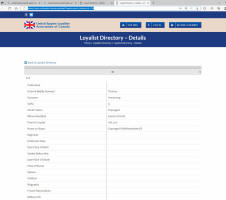
All of the children of Edward
Armstrong Sr., and most of the children of Thomas Armstrong, Sr., U. E.
Loyalists, were eligible to receive a land grant based upon their fathers'
loyalty to the King of England. Thomas Armstrong Jr. was Expunged from the
U. E. Loyalist List in 1804 - 1805.
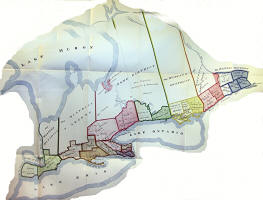

The Province of Upper Canada as it existed about 1800.
The British Constitutional Act of 1791
officially divided the old colony of "Province of Quebec" into the primarily
French-speaking "Province of Lower Canada," and the primarily English-speaking
"Province of Upper Canada." Upper Canada was located upriver, closest to the
source of the St. Lawrence river.
In 1841, the Act of Union officially united the two Provinces
into the single Province of Canada, with the creation of Canada East and Canada
West.
Ontario was known as: "Upper Canada" from
December
26, 1791, to February 10, 1841;
"Canada West" from February 10, 1841, to July
1, 1867; and
"Ontario" after July 1, 1867.
Canada was founded on July 1, 1867. On this
date, the colonies of Canada, New Brunswick, and Nova Scotia linked to form the
sovereign dominion of Canada in a process called confederation. At this time,
Upper Canada and Lower Canada became Quebec and Ontario. Therefore the new
confederation comprised of four provinces: Nova Scotia, New Brunswick, Quebec,
and Ontario. The confederation led to a territorial evolution leading to the
incorporation of other parts of British North America into the newly formed
entity of Canada to form what is today contemporary Canada. Newfoundland and
Labrador was the last province to be incorporated into the confederation in
1949. For a period of many years since Confederation, Canada has undergone many
territorial changes and expansions, eventually forming the current union of ten
provinces and three territories.
The formation of Canada and attainment of its
independence was a gradual process. Despite the existence of a responsible
government in Canada, the United Kingdom continued to claim sovereignty over the
land until the end of the World War I. The 1931 passing of the statute of
Westminster recognized Canada as equal with the United Kingdom but the country
was denied the power to amend its constitution. Dependence on the British
parliament in Canada was removed in 1982 after patriation of the constitution.
Canada is a federal parliamentary democracy and a constitutional monarchy, with
Queen Elizabeth II being the head of state.
Edward
Armstrong of Elizabethtown Twp., Leeds Co., Upper Canada, was an
U. E. Loyalist, and was imprisoned by the Rebels in Albany, in 1777, on account
of his loyalty, and remained a prisoner there until the Treaty of Separation in
1783, when he was liberated. Edward Armstrong came to Canada in 1784, and chose
his residence in Elizabethtown Twp., Leeds Co., Upper Canada. He died in
Elizabethtown Twp., Leeds Co., Upper Canada, in 1795, which was before the
formation of the U. E. List. On June 26, 1807, at York, Ontario, Upper Canada,
Edward Armstrong Jr., requested that his father, Edward Armstrong, be placed on
the List of U. E. Loyalists.
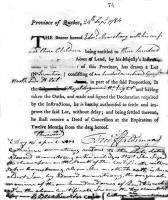
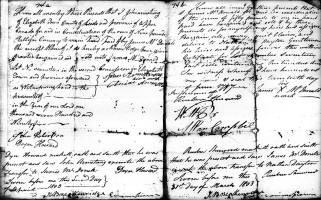
On September 24, 1784, Edward Armstrong, his wife, and three children were
entitled, through a drawing, to three hundred acres of land, in Lot No. 17,
2nd Concession, North.
Adolphus
Armstrong was born about 1789, in the
Province of Quebec.
Charity Dopp was born 1789, in Augusta Twp., Leeds Co., Province of Quebec.
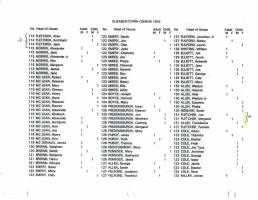
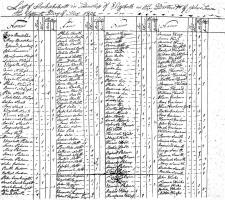
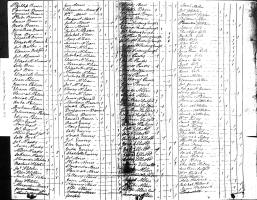
The
May 15, 1802,
Census for
Elizabethtown Twp., Leeds Co., District of
Johnstown, Province of Upper Canada, shows Edward Armstrong is living by
himself. John Fletcher and
Margaret
"Maggie" (Armstrong) (Allen) Fletcher, Theodosius Allen and
Parmelia Fletcher are living in Family No. 114, Elizabethtown Twp.,
Leeds Co., Province of Upper Canada. Fletcher children, Allen Fletcher,
Archibald Fletcher, and Jane Fletcher are living in Family No. 114. The Oliver
Graham Family, consisting of Mary Graham, Oliver Graham Jr., Martin Graham, Mary
Graham, Hannah Graham, John Graham, Sarah Graham, William Graham.
In the 1803 Elizabethtown Twp., Leeds Co., Province of Upper Canada, Census, Caty
Armstrong is living alone, while her young sons, Adolphus Armstrong and and James
Armstrong, are living with
their sister, Margaret and her family with John Fletcher.
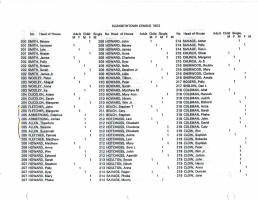
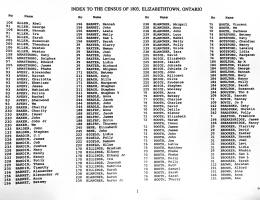
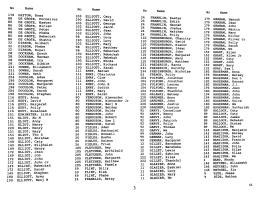
The 1803 Census
for Elizabethtown Twp., Leeds Co., Province of Upper Canada,
shows Catherine
"Caty" (Adams???)
Armstrong is living alone
in Family No.158. John Fletcher,
his wife,
Margaret
"Maggie" (Armstrong) (Allen) Fletcher, Adolphus Armstrong, James
Armstrong, Theodora Allen, Weston Allen, Susannah Allen, and Parmelia
Fletcher, are living in Family
No. 205. West Allen, Hannah Allen, and Abel Allen, are living in Family No. 106.
Edward Armstrong Jr. and Phebe Armstrong are living in Family No. 97.

The 1804 Census for Elizabethtown Twp.,
Leeds Co., Province of Upper Canada, shows John Fletcher, his wife, Margaret
"Maggie" (Armstrong) (Allen) Fletcher, Margaret's mother, Catherine
"Caty" (Adams???)
Armstrong (misnamed Fletcher),
Matthew Allen (misnamed Fletcher), Susannah Armstrong "Sally/Anne" Allen
(misnamed Fletcher), and Matthew Allen (misnamed Fletcher), are living in
Family No. 205.
Adolphus Armstrong is the son of Edward and
Catherine Armstrong, Loyalists who settled in Elizabethtown Twp., Leeds Co.
Ontario. Adolphus Armstrong petitioned for land as the son of a United Empire
Loyalist on November 13, 1810. His father was already deceased. Adolphus Armstrong
had attained the full age of 21 years and swore an oath of allegiance on
September 12, 1810. He was granted 200 acres in Lot 9, Concession 5, Eramosa
Twp., Wellington Co., Province of Upper Canada. Adolphus
Armstrong received a Land Patent on the land on October 1, 1824.
Both Adolphus (No. 7) and John (No. 8 )
also apply for 200 acres of land because they are sons of Edward
Armstrong, Sr. on 13
Nov 1810. They are "supposed to be" at least age 21 in 1810, which means both
were born on/before 1789 to sign the Loyalist agreement.
Adolphus
Armstrong and Charity Dopp were married March 2, 1811, in Augusta Twp.,
Leeds Co., Province of
Upper Canada.
In February, 1812,
Charity Dopp
Petitions for land in Augusta Twp., Eastern
District, Upper Canada, as the daughter of Peter Dopp, UE, and the wife of
Adolphus Armstrong (Upper Canada Land Petitions C-1610 p.218 v.5 Bundle A
10/17).
John later gives the land to his beloved brother Edward, Jr. sometime after his
father dies in 1795 in 7a of which you have placed on your website.
Edward, Jr. signs the Loyalist agreement in 26 Jun 1807 for 200 acres and is a
Blacksmith in Niagara, in the District of Niagara.
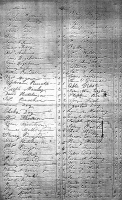
The 1819 Census for Yonge Twp., Leeds Co.,
shows the John Armstrong household has a total of 2 Males and 1 Female. The 1819
Census for Yonge Twp., shows the Adolphus Armstrong household has a total of 2
Males and 3 Females.
Adolphus Armstrong received a Land Patent on the land on
October 1, 1824.
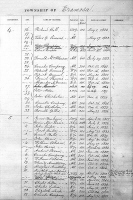
Eramosa Twp., Wellington Co., Province of
Upper Canada, Land Sale records, Concession 5.
Adolphus Armstrong first appears on the
assessment in the spring of 1826. In 1827 only 4 acres are cleared, and 2 more
in 1828.
On August 16, 1828, Charity (Dopp)
Armstrong sold her land in
Eramosa Twp., Wellington Co., Province of
Upper Canada.
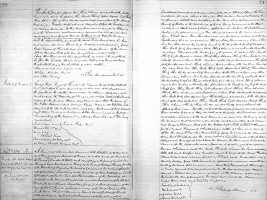
Charity (Dopp) Armstrong sold her land in
Eramosa Twp., Wellington Co., Province of
Upper Canada.
Adolphus
Armstrong died September 25, 1828,
in
Eramosa,
Wellington Co.,
Province of
Upper Canada, at about
age 39.
In the probate for the estate of Adolphus
Armstrong, two death dates are given: 1828 and 1829. It is likely 1828, since
between 1828 and 1829, the assessment roll changes from Adolphus to Charity Armstrong.
Re: Adophus's estate; Suit of Stilman Smith
says Charity remarried 'August last' to James Draper, 'a man of dissipated
habits'; papers of administration of the estate granted to Charity's
brother-in-law, Stilman Smith in trust for her eldest son David.
The petition of Stilman Smith says Adolphus
Armstrong died September 25,
1828, or September 25, 1829,
and left a widow Charity, children Catherine, David (oldest son), Tamson, James,
(ON Surrogate Court Wentworth Co. Probate Records 1312205 File 150 Adolphus
Armstrong.
James Draper and
Charity (Dopp)
Armstrong,
both of Eramosa, Wellington
Co., Province of Upper Canada, were married August 9, 1831, by Rev. Black.
Witnesses: Robt Elliot, John Loree & Wm Everts (Walker & Calder. Marriage
Registers of Upper Canada v. 9 pt. 1 Wellington Co. 115).
Emeline A. "Emma" Draper was
born April 4, 1832, in
Goodwood, Uxbridge Co.,
Province of Upper Canada.
Charity (Dopp) (Armstrong) Draper died 1832, in
Goodwood, Uxbridge Co.,
Province of Upper Canada,
at about age 43.
David Armstrong sells the land Adolphus
Armstrong (son of UE Loyalist, Edward Armstrong) receives from the government on
March 8, 1838. Concession 5; Lot 9.
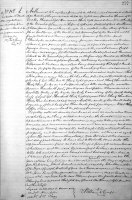
David Armstrong sold
his land in Lot
9, Concession 5, Eramosa Twp., Wellington Co., Province of Upper Canada.
James Adolphus Armstrong
and Cynthia Miller were married Sunday, July 4, 1841, at the house of Abner
Stephens, Justice of the Peace, Lenox Twp., Macomb Co., MI.
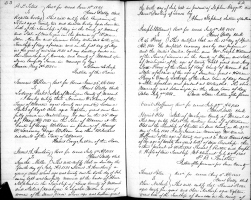
James Adolphus Armstrong
and Cynthia Miller marriage record.
Thomas Dickerson (age 18), a Laborer,
enlisted May 25, 1842, at Syracuse, NY, Deserted August 4, 1843, and Court
Marshaled February 26, 1844, at Buffalo Barracks, NY.
The 1850 U. S. Census
taken on August 30, 1850, shows Martin J. Scott (age
26) born in New York to New York-born parents, and with Real Estate of $325 is a
married Farmer, and is living in the Town of Huron, Wayne Co., NY. Living with
him are: Rachael Scott (age 25) born in Canada; Carver Scott (age 4) born in New
York; Wm. C. Scott (age 1) born in New York; Amanda Dickerson (age 16) born in
New York; and Thomas Dickerson (age 27) born in Canada, a Sailor. Leigh
Larson note: Amanda Malvina Dickerson Married (1) November 7, 1852, in Fox Twp.,
Sullivan Co., PA, to Lewis Henry Shadduck, and had two children. Lewis died at
General Hospital, Hampton, VA, due to Typhoid Fever. Buried in Hampton National
Cemetery, Hampton, VA. Malvina Married (2) October 19, 1884, in Bradford, McKean
Co., PA, to Joseph Clark: Born August 15, 1825, in Ireland; Died September 22,
1899, in Sylvania, Bradford Co., PA. Buried in Hillside Cemetery, Big Pond,
Bradford Co., PA. In 1920, Amanda was living with her son in Canton, Bradford
Co., PA. She was age 85 and had a nurse attending her. Amanda died February 13,
1920, in Alba, Bradford Co., PA (age 74). Buried in Hillside Cemetery, Big Pond,
Bradford Co., PA.
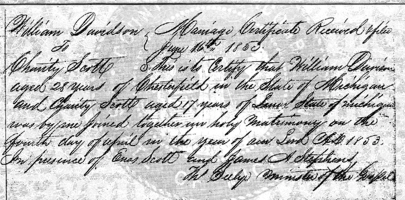
William Davidson and Charity Scott marriage
record.
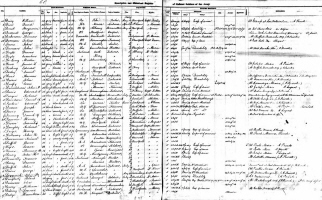
Thomas Dickerson U. S. Army service record.
Thomas Dickerson (age 34), a Fisherman,
enlisted for a term of 3 years, August 14, at Oswego, NY, as a Private in
Company I, 110th Regiment Infantry of the New York State Volunteers, and was
Mustered out due to Desertion on September 24, 1863, at Elmira, NY.
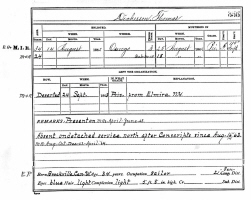
Thomas Dickerson deserted from Civil War
service record.
DICKERSON - Amanda Malvina Dickerson
Shadduck
RECENT DEATHS - Clark.
Mrs. Joseph Clark died February 13, at the
home of her son John Shadduck, at Alba, aged eighty-five. In 1852 she married
Lewis Shadduck and was the mother of two children, Ervin and John. In addition
to these she raised two other children, Lewis and Minerva Wheeler. Mr. Shadduck
enlisted in 1862 in Company B, 58th Regiment, Pennsylvania Volunteers, and died
in service, January 3, 1863. In October, 1884, she married Joseph Clark, who
died a number of years ago. She is survived by the sons and foster children
mentioned, and a number of grandchildren. The funeral was held Monday afternoon
from her son's home, Rev. W. H. Porter officiating. Interment was made in the
cemetery at Sylvania.
Article found in J. B. Shadduck's Bible -
1920 Submitted by Linda Ludwig Mutzer.
Cynthia (Miller)
Armstrong died November 11, 1863, in Michigan at age 39 Years, 1 Month and 1
Day. Buried in Richmond Cemetery, Richmond, Macomb Co., MI.
The 1870 U. S. Census
taken on August 14, 1870, shows Adam Scott (age
57) born in Canada West, and with a father and mother of foreign birth, and with
Real Estate of $500 and Personal Estate of $300 is a Shoemaker, and is living in
the Town of Bridgeton, Newaygo Co., MI. Living with him are: Phebe Scott (age
45) born in Canada West, and with a father and mother of foreign birth, who does
Housekeeping; Walter Scott (age
23) born in Michigan, and with a father and mother of foreign birth, a Farm
Laborer; Harriet Scott (age
18) born in Michigan, and with a father and mother of foreign birth, a Domestic;
Rhoda Scott (age
14) born in Michigan, and with a father and mother of foreign birth, a Domestic;
Fred Scott (age
10) born in Michigan, and with a father and mother of foreign birth; and Medora
E. Scott (age
3) born in Michigan, and with a father and mother of foreign birth.
Adam Bowman Scott
died February 27, 1872, in Bridgeton, Newaygo Co., MI, at age 58. Buried in
Bridgeton Township Cemetery, Bridgeton, Newaygo Co., MI.
Thomas Dickerson
and Phebe Maria
(Armstrong) Scott were married January 26, 1875, in East Saginaw, Saginaw Co.,
MI.

Thomas Dickerson and Phebe Maria
(Armstrong) Scott marriage record.
Thomas Dickerson and Phebe Maria (Armstrong) (Scott) Dickerson
were divorced before 1880, in Michigan. Phebe then assumed her previously
married last name of Scott.
The 1880 U. S. Census taken on June 16, 1880, shows Phebe M.
Scott (age 55) born in Canada to Canada-born parents, is a widowed or Divorced
Head of Household, who is Keeping House, and is living in the Village of Holton,
Muskegon Co., MI. Living with her are: her unmarried son, Fred Scott (age 17)
born in Canada to Canada-born parents, who Works at a Lumber Mill; and her
unmarried daughter, Dora Scott (age 13) born in Michigan to Canada-born parents.
The 1880 U. S. Census taken on June 3, 1880, shows Martin J.
Scott (age 57) born in New York to New York-born parents, is a married Farmer,
and is living in Davison, Genesee Co., MI. Living with him are: his wife, Rachel
E. Scott (age 55) born in Canada to Massachusetts and New York-born parents, and
who cannot read or write, who Keeps House; his unmarried daughter, Mary Scott
(age 16) born in New York to New York and Canada-born parents, and who cannot
read or write; his unmarried daughter, Calista Scott (age 14) born in New York
to New York and Canada-born parents, and who cannot read or write; and a
divorced Boarder, Thos. Dickerson (age 50) born in Canada to Ireland-born
parents, a Boarder.
James Adolphus Armstrong and Anna (McCloud) McGinnis were married
March 29, 1887, in East Saginaw, Saginaw Co., MI.
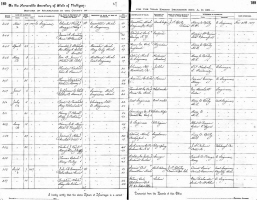
James Adolphus Armstrong
and Anna (McCloud) McGinnis marriage record.
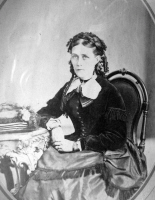
Charity Armstrong Scott.
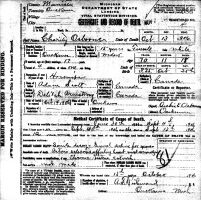
Charity (Scott) Osbourne death record.

Phebe Maria
(Armstrong) (Scott) Dickerson, about 1880, Michigan.
Phebe Maria
(Armstrong) (Scott) Dickerson died March 26, 1903, in Muskegon, Muskegon Co.,
MI, at age 77. Buried in Holton Cemetery, Holton, Muskegon Co., MI.
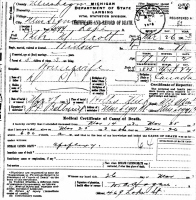
Phebe Maria
(Armstrong) (Scott) Dickerson death
record.
Amanda Malvina (Dickerson) Shadduck) Clark died
February 13, 1920, in Alba, Bradford Co., PA, at age 85. Buried in Hillside
Cemetery, Big Pond, Bradford Co., PA..

Amanda Malvina (Dickerson) Shadduck) Clark
death record.
DICKERSON - Amanda Malvina Dickerson
Shadduck
RECENT DEATHS - Clark.
Mrs. Joseph Clark died February 13, at
the home of her son John Shadduck, at Alba, aged eighty-five. In 1852 she
married Lewis Shadduck and was the mother of two children, Ervin and John.
In addition to these she raised two other children, Lewis and Minerva
Wheeler. Mr. Shadduck enlisted in 1862 in Company B, 58th Regiment,
Pennsylvania Volunteers, and died in service, January 3, 1863. In October,
1884, she married Joseph Clark, who died a number of years ago. She is
survived by the sons and foster children mentioned, and a number of
grandchildren. The funeral was held Monday afternoon from her son's home,
Rev. W. H. Porter officiating. Interment was made in the cemetery at
Sylvania.
Article found in J. B. Shadduck's
Bible - 1920 Submitted by Linda Ludwig Mutzer.
The History Of Upper And Lower Canada
Upper and Lower Canada were formed by the Constitutional
Act of 1791 in response to the wave of United
Empire Loyalists moving north from the United States into the
French-speaking province of Quebec following the American
Revolution (1765-1783). The result was the division of the old Province
of Quebec into two colonies, Lower Canada to the east and Upper Canada to the
West, each with their provincial legislatures. While Lower Canada retained the
seigneurial system, language, and religious institutions of Quebec, Upper Canada
developed on a model of British society.
New Settlers Arrive
In the wake of the American Revolution, United Empire
Loyalists fled northwards to the Province of Quebec, followed by other
English-speaking settlers. By 1790 the influx of new settlers numbered about
10,000. The territories they settled were already occupied by Indigenous
peoples, including the Wendat, Tionontatehronnon, and Algonquin. The Loyalists,
guided by Sir Frederick Haldimand, settled primarily along the St. Lawrence
River in the area of Kingston, along the shores of Lake Ontario by the Bay of
Quinte, and around the Niagara Peninsula. While Quebec had been established as a
British colony with the Treaty
of Paris (1763) and the Royal
Proclamation of 1763, the majority of the population remained
French-speaking. The English settlers, however, brought with them their own
political and religious ideals, and tensions soon arose between the two groups.
One key issue was that of land ownership. The Province of Quebec had established
a seigneurial system that awarded parcels of land to nobles and religious
communities, who then allotted pieces of the land to tenants in return for
farming the land. Used to the freedoms they had held in the Thirteen
Colonies, the new settlers wanted instead to own their lands in their own
right. Similarly, they pushed for representative government, a British system of
parliament, and British civil law. Religion was another point of tension. While
the Roman Catholic Church was the established Church in Quebec, the new settlers
looked to establish their Protestant Church.
In the years prior to the division of Quebec into the Canadas,
Britain had hopes that floods of English settlers would anglicize Quebec. Prior
to the Loyalist wave, the floods did not materialize. The Quebec
Act of 1774 had restored the Catholic Church in Quebec, and the old
French civil law, reversing the Royal Proclamation of 1763. The Canadiens were
not ready to give up their recently restored privileges.
A New Province
The solution arrived at was the division of Quebec. The British
Constitutional Act of 1791 officially divided Quebec into the primarily
French-speaking Province of Lower Canada, and the primarily English-speaking
Province of Upper Canada. Each province established its own government, with an
appointed lieutenant-governor, executive council, legislative council, and
elected representative assembly. While Lower Canada retained the seigneurial
system, language, and religious institutions of Quebec, John Graves Simcoe, the
first lieutenant-governor of Upper Canada, was determined that the new province
would be a model of British society.
Defining “Upper” and “Lower”
The territory of Lower Canada extended west from the Ottawa River
to the Great Lakes, south of Rupert's Land. Lower Canada extended east from the
Ottawa River to the mouth of the St. Lawrence River, including what is now
Labrador.
The terms “upper” and “lower” refer to the relative location of
each province along the St. Lawrence River, which hints at the importance of
rivers as highways for travel in the period. Upper Canada was located nearest
the source of the St. Lawrence, “upriver”. In contrast, Lower Canada was closest
to the mouth of the St. Lawrence, “downriver” (traveling with the current).
Upper Canada
With the establishment of Upper Canada, the seigneurial system of
Quebec was abolished in favor of British freehold land tenure. Established as
the official Church of the province, the Anglican Church received preferential
treatment, for instance being granted large tracts of land as clergy reserves,
"for the support and maintenance of a Protestant Clergy.”
Simcoe established British civil law and
trial by jury, established the provincial capital at York (Toronto), and left a
legacy of road building and town planning. Promises of free land drew more
immigrants to the province. By 1811, the population of new settlers was almost
90,000.
In the early nineteenth-century, control of the province fell
to the “Family
Compact,” a small Conservative group, loyal to the British Crown. They
were chosen from the friends of the lieutenant-governor and appointed to
prominent roles within the government. The Family Compact was known for its
corruption, granting government positions in return for favors of financial or
political support, and preferential treatment of friends and supporters. But
they were also “progressive industrialists,” promoting building programs and
public works. But their aggressive hold on power, confined to a select elite
few, fed political tension.
The War
of 1812 was a defining moment for Upper Canada, which generated patriotic
myths and heroic figures such as Laura Secord, Sir Isaac Brock, and Tecumseh.
The war also strengthened ties with Britain, and immigrants flowed from Britain
into Upper Canada in place of the American immigrants whom the war had halted.
As Upper Canada grew, it struggled economically, and by the 1820s
had fallen into chronic debt. The province also lacked in infrastructures such
as schools, hospitals, and local government. The government’s failings and
corruption all contributed to the 1837-1838 rebellion. Early attempts to push
through political reform, led by those such as Robert Baldwin, were moderate and
unsuccessful. William Lyon Mackenzie took charge of the reformers in 1837 and
left them into armed revolt against the government. The rebellion was defeated,
but reform would follow.
Lower Canada
The Act of 1791 did not put an end to tensions in what was
now, Lower Canada. While the majority of the population remained
French-speaking, the British imposed English as the official language. The House
of Assembly was divided between the English-speaking Tory Party, and the
French-speaking Canadian Party, the House majority. Similarly, two political
papers, The Quebec Mercury and Le
Canadien voiced the interests of the English merchants and the Canadiens,
respectively. Gradually, English began to take over as the language of business;
by 1831, 45%
of Quebec City’s population was English-speaking, and by
1842 they made up 61% of Montreal’s population.
Lower Canada appeared to thrive as the population boomed, growing
from 110,000 in 1784 to 330,000 in 1812. Fur trade and commercial agriculture
continued to dominate the economy. The timber trade grew rapidly after 1806 as
demand rose, in part to meet the needs for shipbuilding. By 1832, however, the
economy was in crisis. The declining price of furs and wheat resulted in a sharp
decline in production, and many farmers were reduced to subsistence farming. The
Province fell into chronic deficit importing wheat from Upper Canada. By the
early nineteenth century, overpopulation had led to land scarcity and an
increasing rural population, fueled in part by British immigrants, which
contributed to class struggle.
These events and conflicts helped to fan the growing nationalism
sentiments which came to a head in the Patriot insurrection of 1837-1838. The
subsidy crisis, attributed to the “château clique”, the problem of customs
duties between Upper and Lower Canada, and rising ethnic tensions all added fuel
to the fire. Tensions boiled over in 1837 and rebellion broke out, “Patriots”
taking up arms against the English army. Poor organization proved fatal to the
rebellion, and the English response was swift and decisive. In response to the
rebellion, Sir John Colborne appointed a special council to govern Lower Canada
in place of the House Assembly until 1841.
The Act
Of Union
In 1838, Lord Durham, sent to report on the rebellions in Upper
and Lower Canada, condemned the “political cliques”, the Family Compact and
château clique”. He advocated for the establishment of responsible government
and the amalgamation of Canadas into a single Union, as well as the assimilation
of the French Canadiens.
In 1841, the Act
of Union officially
united the two Canadas into the single Province of Canada.
Parents--
Enos Scott (Enos1)
and
Christine Bowman Scott
Marriage--
On 22 Apr 1833, Rev. Samuel Baker (Minister Regular Baptist Church of
Malahide, Elgin, Ontario, Canada) performed wedding of
GROOM--Adam Bowman Scott (resident of Southwold, Elgin, Ontario, Canada, age
20)
and
BRIDE--Tamson Delila/Deliliah Armstrong Strong (resident of Yarmouth, Elgin,
Ontario, Canada, age 18).
Witnesses--Jacob Scott (older brother of groom) and Anson D. Simons.
Children of this marriage (list work in process)--
Elijah D Scott 1833-1897
-----
LIFE and TIMES--
The Bowman family (from mother Christine Bowman Scott's lineage) were English
"Loyalists" who fled the Tunkhannock, Pennsylvania area in the winter of 1777/78
and found refuge in Niagara, Canada. They were fighting members of "Butler's
Rangers" (Captain Walter Butler's Company of Rangers; Kings Royal Rangers of New
York K.R.R.N.Y). Enos Scott (Enos1) and his son Adam Bowman Scott and Jobe W
Scott were captured by American "Patriots". (more details on this later.dht)
|



























